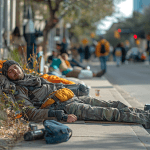Are There Homeless Encampments in Dallas?
Yes, Dallas is actively addressing the presence of homeless encampments within the city, demonstrating a multifaceted approach to this complex issue. The Dallas City Council is exploring the development of City-sanctioned homeless encampment sites, following recommendations from the Homelessness, Organizations, Policies, and Encampments (HOPE) task force. This initiative highlights a shift towards creating structured environments for the homeless population, potentially offering an alternative for individuals who decline traditional shelter services 1.
In conjunction with efforts to organize encampment sites, Dallas has also proposed significant funding towards addressing current encampments throughout the city. A budget proposal by City Manager T.C. Broadnax includes $3.6 million aimed at decommissioning, cleaning, and fencing off areas known for homeless encampments. This move is part of a broader strategy to manage and eventually reduce the visibility and impact of such encampments on the community and the individuals residing within them 2.
The city’s response to homeless encampments is part of a larger initiative aimed at reducing homelessness through the R.E.A.L. Time Rehousing initiative, which seeks to house thousands of individuals and families by 2025. By focusing on decommissioning encampments and offering housing and supportive services, Dallas is working to ensure that efforts to clear encampments are both humane and effective, aiming to provide long-term solutions to individuals affected by homelessness 3.
These steps reflect Dallas’s commitment to addressing homelessness with compassion and strategic planning, emphasizing the need for community support and innovative solutions to support its homeless population. The city’s approach shows an understanding that homelessness is a multifaceted issue requiring a combination of enforcement, support, and housing solutions to effectively address the needs of its homeless residents.
Get Free Our Report: “7 Steps That Get 90% Off The Street”
Where is Tent City Dallas?
Tent City in Dallas was the city’s largest homeless encampment, stretching for five blocks under the I-45 bridge near downtown. This encampment became a significant hub for the homeless population, providing a makeshift community space albeit with challenging living conditions. Due to safety and health concerns, including violence and unsanitary conditions, local advocates and city officials called for its closure. The closure process began in early May 2016, with efforts to relocate residents to safer accommodations, including private housing and emergency shelters. Despite the dismantling of Tent City, the challenge of homelessness in Dallas remained, highlighting the need for more comprehensive solutions, such as increased affordable and permanent housing with supportive services for those facing economic, medical, and mental health challenges 4, 5.
Since the closure of Tent City, the city of Dallas has been exploring various strategies to address homelessness more effectively. These include sanctioned encampments, where homeless individuals can reside without the typical barriers of homeless shelters, such as sobriety requirements. The Dallas City Council has been considering plans for these sanctioned sites to provide a structured environment for those who decline traditional shelter services. Additionally, the city proposed a $3.6 million budget to manage homeless encampments through cleaning, fencing, and other measures aimed at preventing the re-establishment of such encampments. This initiative is part of a broader effort, including the R.E.A.L. Time Rehousing initiative, which aims to house thousands of individuals and families by 2025, demonstrating a commitment to finding long-term solutions to homelessness 6, 7.
These actions reflect Dallas’s ongoing efforts to tackle homelessness with a combination of immediate interventions and strategic long-term planning, aiming to ensure safer and healthier living conditions for its homeless population.
Are Homeless Encampments Illegal in Texas?
In Texas, a state law has been enacted that makes it illegal to camp in unapproved public places, classifying it as a Class C misdemeanor. This law was introduced as a response to cities like Austin, which had lifted local bans on public camping, leading to a noticeable increase in homeless encampments. The law aims to address homelessness by redirecting those affected to shelters and support services. It reflects a significant step by the state to manage public spaces while attempting to connect homeless individuals with resources aimed at aiding them towards stability and housing 8.
Homeless No More is on the frontline, offering innovative solutions and support to those affected by homelessness. By contributing to Homeless No More, you’re supporting a mission that has proven successful in helping individuals transition off the streets into meaningful, stable lives. Together, we can extend this mission across the U.S., reaching more individuals in need. Discover how you can make a difference today.
What City is Banning Homeless Encampments?
In recent years, cities across the United States have been implementing bans on homeless encampments, responding to increased visibility and challenges related to homelessness. Texas, for example, has passed legislation banning homeless encampments statewide, a move following Austin’s decision to reinstate a local ban. These measures aim to address public concerns and redirect homeless individuals to shelters and resources. However, Dallas’s approach has included efforts like the closure of Tent City, focusing on relocating its residents to safer accommodations while highlighting the need for more permanent housing solutions 9.
Report Homeless Encampment Dallas
To report homeless encampments in Dallas, the City of Dallas’s Office of Homeless Solutions recommends using the 311 service accessible by phone, mobile app, or online. This approach ensures that each request is documented, tracked, and addressed appropriately by the street outreach team. Community involvement in reporting is vital. It not only aids in the efficient allocation of resources but also highlights areas requiring immediate attention, thereby fostering a more coordinated response to homelessness. Engaging with the system contributes to the broader effort of making Dallas a safer, cleaner, and more supportive community for all its residents 10.
Dallas Homeless Shelters
Dallas LIFE: A Comprehensive Approach to Recovery
Dallas LIFE offers a clear message of renewal and hope – and is the largest homeless recovery center in North Texas. Recognizing the diverse needs of those it serves, this facility provides a variety of programs, including the Homeless No More Program, aimed at facilitating long-term recovery. Essential services like meals, shelter, and clothing, alongside specialized programs for veterans, seniors, and families, underscore Dallas LIFE’s commitment to serving the entire homeless population. Importantly, the facility emphasizes the need for community support and volunteer involvement, critical components in the fight against homelessness. Mentors and counseling are key facets in personalizing the care and support of each resident. When residents at Dallas LIFE enroll in the Homeless No More recovery program, the different phases take, on average, 10 months to complete. Upon completion, the graduates are celebrated in an elaborate graduation ceremony – complete with cap and gown – and photoshoot! With more than 500 graduates through the years, their statistics on recovery show that 90% of graduates are never homeless again. For seniors, veterans and those program participants with disabilities (physical, mental or emotional), the Homeless No More program has tailored the program to meet their abilities AND help them navigate any governmental support services they have not utilized in the past.
The Bridge: A Place to Begin Again
The Bridge, a unique model in Dallas, offers emergency shelter to 250 guests each night and various other services. From providing basic needs like meals and showers to more intensive support such as health evaluations, case management, and employment services, The Bridge exemplifies a holistic approach to aiding those in need. This shelter’s inclusive environment extends even to guests’ canine companions, offering on-site kennel services. 11.
Austin Street Center: Personalized Plans for a Path Forward
For over three decades, Austin Street Center has been one of Dallas’s largest homeless shelters. Beyond emergency housing, Austin Street Center prides itself on its servant leadership and programs, crafting individualized plans to guide clients towards permanent housing solutions. The shelter’s commitment to collaborative care highlights the importance of personalized support in the journey to recovery 12.
Get Homeless No More for Your Shelter, Non-Profit or Business.
Hotel Vouchers for Homeless Dallas
In Dallas, the struggle against homelessness takes a multifaceted approach, embracing innovative solutions to provide immediate relief and long-term support to those in need. A key element in this effort is the hotel voucher system, which serves as a critical bridge for many on their journey to permanent housing.
Hotel Voucher System for the Homeless
Dallas has seen partnerships between non-profit organizations and local authorities to convert former hotels into living spaces for the homeless. For instance, Catholic Charities, in collaboration with its partners, is transforming a North Dallas hotel into 180 efficiency apartments for homeless adults. This initiative, named St. Jude – Park Central, is part of a broader strategy to offer permanent supportive housing, along with transitional and rapid rehousing services, to those likely to secure stable housing more swiftly. This $14.9 million conversion aims to furnish residents with not just a place to stay but also access to critical social services and support networks essential for a successful transition out of homelessness 13.
Looking at Success Stories and Community Impact
Such programs have proven to be more than just a temporary fix; they can lay the groundwork for long-term recovery and reintegration into society when the root causes of homelessness are addressed in the individual. By providing a stable address, these initiatives help individuals gain access to job training, medical care, and other essential services. For example, residents of these transformed hotel apartments enjoy amenities and support designed to foster independence, such as in-house case management, job readiness training, and health services. The approach of allowing residents to maintain their autonomy — such as having no curfews unlike other shelters—plays a significant role in rebuilding their lives 14.
The Emergency Housing Voucher (EHV) program, funded through the American Rescue Plan Act of 2021, further exemplifies the city’s commitment to addressing homelessness. Administered by the Texas Department of Housing and Community Affairs, this program has allocated 380 vouchers across Texas, targeting individuals and families who are homeless, at risk of homelessness, or fleeing domestic violence, among other criteria 15.
Additionally, Dallas County’s CARES Act Funding includes the Emergency Housing Assistance Program (EHAP), offering short-term rental, mortgage, and utility assistance to low-income residents affected by COVID-19. This initiative aims to prevent the escalation of homelessness by providing up to six months of housing assistance, subject to funding availability 16.
Get Homeless No More for Your Shelter, Non-Profit or Business.
Dallas Homeless Population
In Dallas, addressing the homeless population requires a deep understanding of its current state and the diverse needs of those who find themselves without a home. The 2022 Point-in-Time Count, a pivotal annual assessment, sheds light on the complexities and scale of homelessness in Dallas and Collin counties. This count is instrumental in tailoring the city’s response to homelessness, ensuring that strategies are data-driven and reflect the real-time needs of the community. 17
Current Statistics
The latest statistics indicate a nuanced picture of homelessness in Dallas. In 2022, the Point-in-Time Count revealed a total of 4,410 individuals experiencing homelessness in both Dallas and Collin counties, with the vast majority located in Dallas County. 18 This represents the lowest homelessness count since 2019, signaling a positive trend towards reducing the homeless population in the region. This decrease can be attributed to the success of eviction prevention and housing intervention initiatives, which have played a crucial role in supporting individuals and families at risk of homelessness. 19
Demographics and Needs
The demographics of the homeless population in Dallas underscore the importance of targeted support and interventions. A significant aspect of this demographic reality is the disproportionate representation of Black North Texans among the homeless population, accounting for 54% of the total homeless population in Dallas and Collin counties, despite making up only 18% of the general population. This stark disparity highlights the need for solutions that address systemic inequities and provide targeted support to those most affected by homelessness. 20
The needs of the homeless community in Dallas are diverse, encompassing immediate necessities such as shelter and food, as well as longer-term needs like access to healthcare, job training, and affordable housing. Chronic homelessness and a rise in families returning to homelessness emphasize the need for sustained support and interventions that go beyond temporary relief, focusing on pathways to permanent housing and stability that include addressing the root triggers of homelessness such as drugs, alcohol, poverty, broken relationships, and mental illness.
Dallas Homeless Solutions
In Dallas, the fight against homelessness is spearheaded by concerted efforts from the city, non-profits, and community organizations, showcasing both existing solutions and innovative approaches to meet the diverse needs of the homeless population. The Office of Homeless Solutions (OHS) positions itself as a catalyst for change within the community, pushing forward strategic initiatives and street outreach with a focus on consistency, transparency, and accountability. Their mission encapsulates providing essential services such as food, shelter, and housing, while also addressing barriers and creating opportunities for a better life for Dallas’s homeless individuals 21.
A standout initiative under the OHS is the R.E.A.L. Time Rehousing Initiative (RTR), aimed at drastically reducing the number of homeless residents in Dallas by housing over 2,700 individuals by 2023 and setting an ambitious new goal of housing 6,000 unique individuals by 2025. This initiative represents a significant stride towards reshaping the lives of Dallas’s homeless community members, making the city safer, healthier, and more inclusive. The RTR focuses on rapid rehousing, providing those deemed likely to maintain stable housing with a 12-month rental subsidy and a comprehensive support package including move-in kits, mental healthcare, food assistance, job training, and placement. For those assessed as chronically homeless or unlikely to sustain housing after one year, Emergency Housing Vouchers (EHVs) offer a longer-term solution with permanent rental subsidies and services as long as the individual qualifies 22.
The success of such initiatives relies heavily on community involvement and the support of both public and private partners. By aligning efforts and resources, Dallas should aspire to not only meet the immediate needs of its homeless population (which most of these programs try to do) but also to tackle the root causes of homelessness (which Homeless No More does), paving the way for sustainable solutions.
These efforts are indicative of a broader shift towards innovative, comprehensive approaches to homelessness, underscoring the importance of collaboration, strategic planning, and community support in addressing one of the city’s most pressing issues. Through its initiatives, Dallas sets a precedent for other cities grappling with similar challenges, showcasing the potential impact of targeted, well-supported strategies in making homelessness brief, rare, and non-recurring.
The progress and effectiveness of these initiatives reflect a commitment to not just manage but significantly reduce homelessness in Dallas, highlighting the critical role of innovative solutions and community involvement in achieving lasting change.
The article above outlines Texas’s approach to managing homeless encampments, emphasizing laws that make public camping a misdemeanor, aiming to redirect affected individuals to shelters and services. Highlighting the necessity of community involvement, they called for support towards organizations like Homeless No More, which work tirelessly to provide stable housing and support services. Reinforcing the importance of community action, these discussions underscore a collective responsibility towards aiding our homeless neighbors and urging for contributions to extend impactful programs nationwide.
_____
For more details on the initiatives and how you can help, visit the Homeless No More website and consider contributing to their cause.
References
- https://dallasexpress.com/city/city-to-pursue-sanctioned-homeless-camps/
- https://familygateway.org/dallas-proposes-3-6-million-to-raze-clean-and-fence-homeless-encampments/
- Ibid.
- https://www.texasobserver.org/tent-city-dallas-feature/
- https://www.texastribune.org/2016/05/17/after-tent-city-push-more-housing-homeless/
- https://dallasexpress.com/city/city-to-pursue-sanctioned-homeless-camps/
- https://familygateway.org/dallas-proposes-3-6-million-to-raze-clean-and-fence-homeless-encampments/
- https://www.texastribune.org/2021/05/20/texas-homeless-camps-ban-legislature/
- https://www.texastribune.org/2021/05/20/texas-homeless-camps-ban-legislature/
- https://dallashomelesssolutions.com/our-initiatives/311-service-requests/
- https://www.bridgehrc.org/
- https://austinstreet.org/
- https://www.dmagazine.com/philanthropy-nonprofits/2021/08/this-north-dallas-hotel-will-be-permanent-housing-for-those-experiencing-homelessness/
- https://www.dmagazine.com/philanthropy-nonprofits/2021/08/this-north-dallas-hotel-will-be-permanent-housing-for-those-experiencing-homelessness/
- https://www.thn.org/ehv/
- https://www.dallascounty.org/cares-act/housing-assistance-en.php
- https://www.thn.org/2022/07/06/2022-pit/
- https://unitedwaydallas.org/updates/join-us-for-the-2023-point-in-time-homeless-count/#:~:text=The%20most%20recent%20PIT%20Count,than%20400%20in%20Collin%20County).
- https://www.thn.org/2022/07/06/2022-pit/
- https://unitedwaydallas.org/updates/the-state-of-homelessness-in-2022/
- https://dallascityhall.com/departments/homeless-solutions/Pages/default.aspx
- https://dallashomelesssolutions.com/our-initiatives/dallas-r-e-a-l-time-rapid-rehousing/
0022





